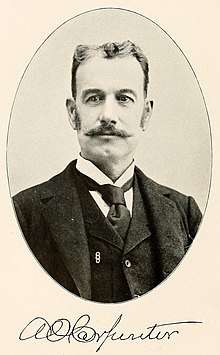Aurelius O. Carpenter
A. O. Carpenter (born Aurelius O. Carpenter) (1836-1919[2]) was an American photographer, writer and abolitionist. He was one of the earliest photographers in early American California, photographing Mendocino County, California. He was the son of Clarina I. H. Nichols and the father of Grace Carpenter Hudson and Grant Carpenter. Prior to moving to California, he was active in the abolitionist movement, fighting with John Brown in the Battle of Black Jack.
A. O. Carpenter | |
|---|---|
Aurelius Ormando Carpenter | |
 | |
| Born | 1836 Vermont, United States, United States[1] |
| Died | 1919 (aged 82–83) United States |
| Resting place | Ukiah Cemetery, Ukiah, California |
| Nationality | American |
| Known for | Photography of early Mendocino County, California |
| Spouse(s) | Helen McCowan |
Life
Aurelius Carpenter was born in 1836 in Vermont. His mother was Clarina I. H. Nichols. As a teenager, he had an apprenticeship at the Windham County Democrat, the newspaper owned by his stepfather, George Nichols.[1]
In 1854 (or 1855[3]), Carpenter, his mother, and his brother, Chapin, left Vermont to Kansas to support abolitionist activities.[1] Carpenter joined abolitionist John Brown on June 2, 1856, fighting in the Battle of Black Jack.[1]
Carpenter married writer and photographer Helen McCowan in late 1856.[1] He had met McCowan while he was recovering from injuries sustained during the battle and she had served as Carpenter's nurse. He headed further west with Helen, to California. Helen's family had moved to California, where her brother joined the mining industry.[3] The couple settled in Potter Valley in Mendocino County in 1859.[1][3] It was in Potter Valley where Carpenter started the first newspaper in Mendocino County, the Mendocino Herald. He also wrote for the San Francisco Fair Daily and the Ukiah City Press.[3]
Eventually, the couple relocated to Ukiah.[3] They started a commercial photography studio, which they operated for 40 years.[3] They had a daughter, Grace and a son, Grant.[1]
In September 1856, the Carpenter's hosted Susan B. Anthony at their home in Ukiah when Anthony visited the city to speak at a rally.[4]
Carpenter died in 1919 in Ukiah, California.[2]
Work
Carpenter's work focused on the early development of 19th and 20th century Mendocino County, California. Carpenter photographed panoramas of the coast, forests, and early industry, including logging and shipping. He documented the Pomo people and early white settlers, including Charmian London.[5]
In the 1960s, 700 glass plate negatives of Carpenter's photographers were found in the basement of the Sun House in Ukiah, the home where Carpenter's daughter Grace Hudson and her husband, John Hudson, lived. Local Ukiah photographer Robert Lee gathered the negatives and researched and created prints of the negatives, documenting the subjects seen in the images. It took forty years for Lee to complete the project. As a result, the first exhibition of Carpenter's work was held in 2006 at the Grace Hudson Museum, also celebrating the museums 20th anniversary.[1]
His works are held in the collection of the Sonoma County Library, SFMOMA and the Grace Hudson Museum.[1][5][6]
Further reading
- Publications by A. O. Carpenter
- Carpenter, Aurelius O. History of Mendocino and Lake Counties, California, with Biographical Sketches of the Leading, Men and Women of the Counties Who Have Been. Los Angeles (1914). ISBN 115338468X
- Publications about A. O. Carpenter
- Schenck, Marvin A., Karen Holmes, and Sherri Smith-Ferri. Aurelius O. Carpenter: Photographer of the Mendocino Frontier. Ukiah: Grace Hudson Museum (2006). ISBN 0974030023
References
- Geniella, Mike (5 October 2006). "Ukiah". Santa Rosa Press Democrat. Retrieved 29 September 2018.
- "Aurelius Ormando Carpenter". Find A Grave. Retrieved 29 September 2018.
- Darline Bergere (16 March 2015). Legendary Locals of Ukiah. Arcadia Publishing Incorporated. p. 11. ISBN 978-1-4396-5037-0.
- Ann D. Gordon (10 January 2013). The Selected Papers of Elizabeth Cady Stanton and Susan B. Anthony: An Awful Hush, 1895 to 1906. Rutgers University Press. p. 97. ISBN 978-0-8135-5345-0.
- "Crew working on right-of-way of the California Northwestern Railroad between Cloverdale and Hopland, California, ca. 1896". Sonoma Library. Retrieved 29 September 2018.
- "A. O. Carpenter, Untitled [Fence chute, Mendocino], ca. 1880". SFMOMA. Retrieved 29 September 2018.
External links
| Wikimedia Commons has media related to A. O. Carpenter. |